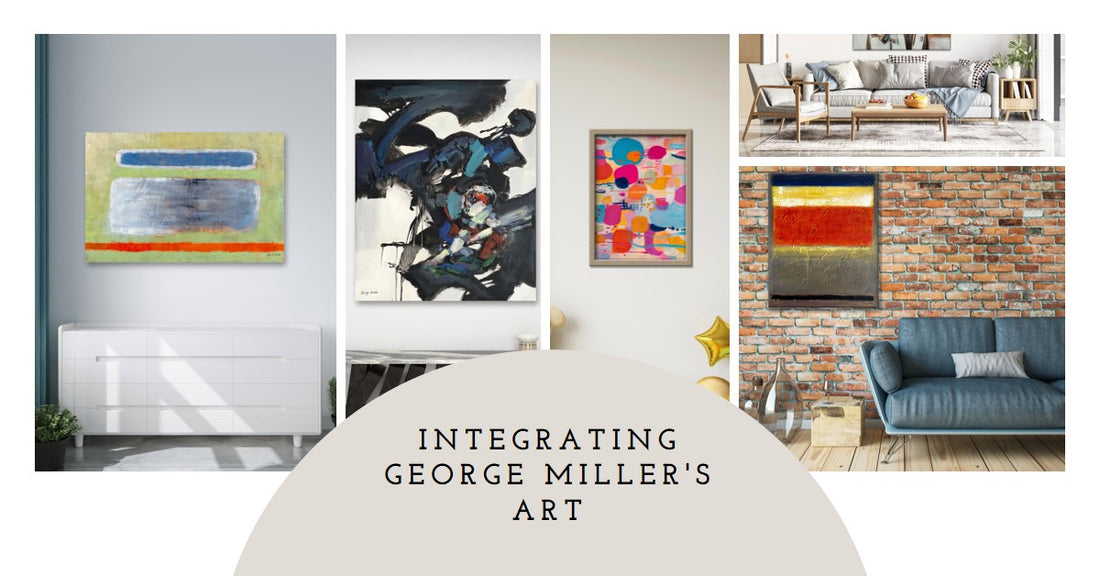In the realm of interior design, where clean lines and minimalist aesthetics often reign supreme, incorporating art becomes essential for injecting personality and warmth into a space. George Miller, with his distinctive style of hand-painted abstract art, offers a compelling solution for those seeking to elevate their modern homes with captivating visuals and a touch of artistic flair. Characterized by bold colors, rich textures, and a sense of dynamic energy, Miller's work seamlessly blends with contemporary design sensibilities while adding a unique focal point to any room.
One of the most appealing aspects of Miller's art is its versatility. His abstract pieces, often featuring a captivating interplay of color and form, possess a remarkable ability to complement a wide range of modern interior styles. For instance, in a minimalist setting dominated by neutral tones and clean lines, a vibrant abstract painting by Miller can instantly inject a much-needed dose of color and become a captivating focal point, drawing the eye and adding a sense of depth and dimension. In contrast, within an industrial-style home, the raw, textural quality of Miller's brushstrokes can create a harmonious dialogue with exposed brick walls and metal accents, adding a layer of artistic sophistication to the space. Similarly, in a Scandinavian-inspired interior, characterized by its emphasis on natural light and organic materials, Miller's pieces, particularly those with softer color palettes and organic forms, can enhance the overall aesthetic by adding a touch of artistic warmth and visual interest.
When selecting and placing George Miller's artwork in a modern home, it's important to consider the function and overall style of each room. Larger pieces can make a bold statement as the centerpiece of a living room, hung above a sofa or fireplace. In a dining area, a medium-sized artwork placed on a wall adjacent to the dining table can create a stimulating ambiance for conversations and gatherings. For bedrooms, smaller pieces strategically placed on a bedside table or dresser can infuse the space with a sense of tranquility and personal style. Choosing the right frame is equally important; a sleek, minimalist frame in a neutral tone like black or white can beautifully complement the artwork without detracting from its impact, while also harmonizing with the modern aesthetic.
To further enhance the visual impact, consider creating a gallery wall by grouping together multiple pieces of Miller's artwork. Experiment with different sizes, compositions, and frame styles to create a dynamic and personalized display that reflects your unique taste. Ultimately, the key to successfully incorporating George Miller's abstract art into a modern home lies in embracing the interplay between the artwork's vibrant energy and the clean simplicity of contemporary design. By thoughtfully selecting and placing these captivating pieces, you can transform your living spaces into stylish and inspiring havens that reflect your appreciation for both art and modern living.


This design style can be categorized as modern minimalist, leaning towards a cool and austere color palette. The large-scale abstract painting serves as the visual center of the entire space, immediately drawing the eye. The blue and red blocks in the painting contrast with the black and white tones of the room, breaking the monotony and adding a touch of vibrancy. The abstract expression and bold strokes of the artwork echo the minimalist style of the room and the geometric lines of the furniture, enhancing the artistic and modern feel of the overall design. In conclusion, this abstract painting injects vitality and artistic flavor into an otherwise simple space, becoming the finishing touch.

This design style is industrial, but also incorporates some modern minimalist elements. The large areas of red in the painting echo the color of the brick wall, while the yellow and blue blocks contrast with the sofa and some of the furniture, enriching the color layers of the space. The minimalist lines of the abstract painting contrast with the roughness of the industrial style, adding a touch of modernity and artistry to the space and avoiding being too cold and harsh. The painting's eye-catching colors and clean composition make it a visual focal point on the brick wall, drawing the eye.

This corner features a minimalist Scandinavian design style. The abstract painting on the wall, dominated by refreshing green tones, echoes the simple and natural characteristics of Scandinavian style. The embellishment of blue-gray blocks and orange lines in the painting adds a touch of brightness to the space, echoing the colors of the curtains and greenery, making the overall space more harmonious and unified.

This children's room features a lively and adorable modern design style with a touch of Scandinavian influence. The abstract painting on the wall is vibrant and bright, harmonizing with the overall cheerful ambiance of the room. The use of geometric shapes like circles and squares in the painting also complements other decorative elements in the room, such as the round rug and star-shaped balloons, creating a space full of childlike wonder.

